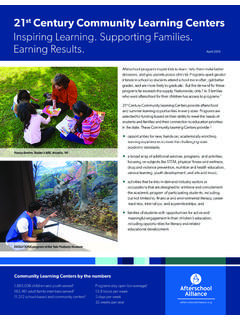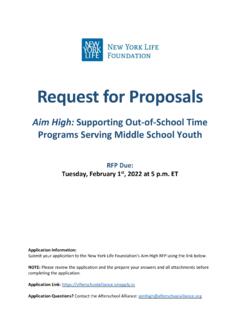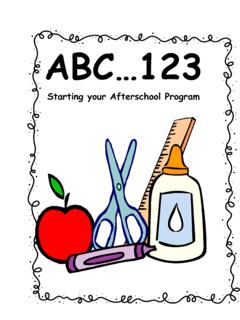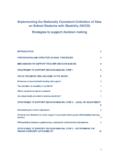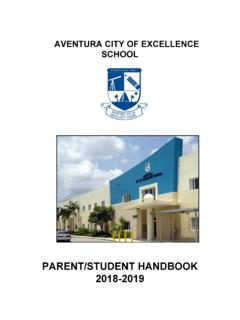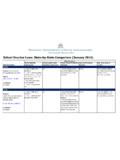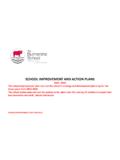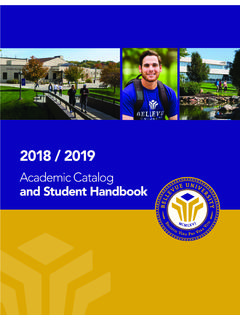Transcription of AFTERSCHOOL ALERT Programs Using Data to …
1 Issue Brief No. 66 August 2014 AFTERSCHOOL ALERT In my years researching the effects of AFTERSCHOOL Programs on children s social and academic outcomes, I have observed the power that high quality Programs can have on the learning and development of young people. 1 In this statement, Dr. Deborah Lowe Vandell highlights two important and related points about AFTERSCHOOL . The first is the positive impact AFTERSCHOOL Programs can have on the students they serve impact on a student s academic performance, as well as socio-emotional development. The second is that the quality of an AFTERSCHOOL program is key to student outcomes, which is corroborated by findings from other studies of the AFTERSCHOOL field. For instance, a meta-analysis by the Collaborative for Academic, Social and Emotional Learning (CASEL) reviewed 68 AFTERSCHOOL program studies and compared AFTERSCHOOL Programs that had an intentional program design grounded in evidence-based practices to those that did The review found that students in the Programs that employed the evidence-based practices saw significant gains in academic performance, school day attendance and positive behaviors.
2 The same improvements were not seen among students in the other set of Programs . A separate meta-analysis looking only at quality AFTERSCHOOL Programs found that students regularly participating in the Programs scored higher on Looking at the data : AFTERSCHOOL Programs Using data to better Serve students 1 standardized math tests, were less likely to demonstrate aggressive behavior, and used drugs and alcohol less compared to their non-participating A program s structure, design and implementation all factor into its impact on the students it serves an AFTERSCHOOL program that evaluates its programming and services is able to gain valuable information and learn how successfully it has implemented its activities and achieved the outcomes it set out to A clear vision and mission, collecting data on outcomes aligned with goals, assessing impact, and making adjustments and adding supports as necessary to start the cycle over again are all components of a continuous improvement loop that can help an AFTERSCHOOL program identify how to better meet the needs of their students .
3 Families and staff. What Can AFTERSCHOOL Programs Gain Through data Collection and Evaluation? data which include everything from survey feedback to attendance records to scores on tests of skills and knowledge gained can serve as a valuable resource for AFTERSCHOOL Programs , as well as their students and families. It is an indicator, or indicators, that Programs can use to improve their understanding of how well their offerings are being implemented and what their The AFTERSCHOOL Alliance, in partnership with MetLife Foundation, is proud to present the final issue brief in our latest series of four issue briefs examining critical issues facing middle school youth and the vital role AFTERSCHOOL Programs play in addressing these issues. This series explores AFTERSCHOOL and: the Common Core State Standards, students with disabilities and other special needs, data utilization to improve programming, and keeping children safe and supported.
4 The briefs examine just a few of the ways AFTERSCHOOL Programs support middle school youth, families and communities. Looking at the data : AFTERSCHOOL Programs Using data to better Serve students Looking at the data : AFTERSCHOOL Programs Using data to better Serve students impact is. It allows Programs to identify what their strengths are and where changes need to be made. AFTERSCHOOL Programs that collect data then have the opportunity to review and analyze their data , which in turn can help a program determine if it is carrying out activities and services in the way that was intended. If the data do not meet the program s expectations, the information gathered can be used to determine necessary steps to address the issue. Alternatively, if it does correspond with what the program envisioned, the data can help Programs see if those activities and services are helping them to accomplish their overarching goals, and if other adjustments can be made to better meet the needs of their staff, students and For instance, a three-year study that looked at the impact of a continuous quality improvement system* found that AFTERSCHOOL Programs implementing the system saw program instruction by staff improve, focus on the quality of instruction improve and a small positive effect on retaining short-term data collection also presents the opportunity for AFTERSCHOOL Programs to develop and strengthen relationships with schools and school districts.
5 For Kids Only AFTERSCHOOL , an AFTERSCHOOL program in Massachusetts, worked closely to build and maintain a partnership with Everett Public Schools communicating regularly with school day staff and sharing attendance and academic performance Additionally, data collection and analysis can help AFTERSCHOOL Programs demonstrate to their community, potential funders and policy makers that they are making a difference in their students lives whether it is helping them aspire to attend college, building their self-confidence and leadership skills, or improving health and wellness. Spark Chicago, which is a part of the Spark Program with branches in six cities across the , was launched in 2011 and served 63 students . In the course of two years, Spark Chicago more than doubled their enrollment numbers, serving more than 200 7th and 8th graders during the 2013-2014 school year.
6 The program serves a high need group, more than 9 in 10 students in the program qualify for the Federal Free or Reduced Price Lunch Program and more than 80 percent of students are African American. Spark Chicago employs a variety of evaluative methods to ascertain program data and qualitative feedback to improve its model. These methods include pre- and post-program surveys on a variety of aspects, like self-confidence, curiosity, and the ability to communicate effectively and ask for help; a data -sharing partnership with Chicago Public Schools; and 2 This recent knowledge that high-quality AFTERSCHOOL Programs work and make a positive difference is indeed a game changer. This means that we should spend much less time arguing about whether quality AFTERSCHOOL Programs work and much more time on working to ensure that all Programs are effective and to make high- quality Programs more accessible and scalable.
7 - Carol McElvain, director, AFTERSCHOOL and Expanded Learning, American Institutes for Research * The Youth Program Quality Intervention is a continuous improvement model that includes quality assessment, improvement planning, coaching by site managers during staff instruction, and staff attendance at targeted trainings for instructional skill building. tracking student attendance and mentor retention. Spark Chicago s most recent data show that 72 percent of their students reported learning how to communicate with adults and 81 percent stated that participating in the program made them more interested in learning new things. This sentiment was echoed in parent surveys, in which 77 percent of parents noted that Spark Chicago made their child more excited about learning. Spark Chicago also collects longitudinal data . It found that 92 percent of apprenticeship program alumni through the class of 2012 have completed high school.
8 What Are the Steps Necessary to Evaluate a Program? However, before AFTERSCHOOL Programs dive into the evaluation process, it is important to start first with a clear understanding of what they want to accomplish, why they want to accomplish it, and how they will accomplish it. In her article Using Research to Continuously Improve AFTERSCHOOL Programs : Helping Student to Become 21st Century Lifelong Learners, Denise Huang, project director and senior researcher at the National Center for Research on Evaluation, Standards, and Student Testing at the University of California, Los Angeles, outlined the quality indicators of AFTERSCHOOL Programs under three categories: program structure, program content and program An AFTERSCHOOL program s structure includes a mission and vision statement that clearly outlines the program s goals, as well as a theory of change that helps drive the program toward the desired long-term Programs that have a strong understanding of their mission and vision for the future are able to develop the activities and services that align with their objectives and make progress toward achieving their goals.
9 Just as important as program content is program implementation, which includes employing strong staff who have the ability to lead and run program activities, as well as develop positive relationships with students and families in the program. Also integral is having solid leadership in place that can provide direction, motivate staff and make sure staff are equipped with the tools and resources needed to carry out their duties; and forging sound relationships with students , families, schools and the community. Once a program s quality indicators are defined, organized and executed, AFTERSCHOOL Programs can take the next steps and determine what data should be collected in order to review how their program is running, observe interactions and relationships between staff and students , evaluate if their program is having the impact they envisioned, and determine if the program is moving toward the goals of the organization.
10 Common elements of assessment tools measuring youth development program quality include examining the program s organization and curriculum structure; accessibility of activities; the program environment; and the relationship between program participants and program staff, including levels of engagement in activities, 3 Current, reliable information is the engine of AFTERSCHOOL systems. With reliable data , AFTERSCHOOL organizers can chart the progress of their efforts, recognize problems and possible remedies, handle matters ranging from program location to program improvements and arm themselves with the facts to build a compelling case about AFTERSCHOOL for funders and the public. In other words, good data power good decision making. - better Together: Building Local Systems to Improve AFTERSCHOOL , The Wallace Foundation Looking at the data : AFTERSCHOOL Programs Using data to better Serve students understanding and acceptance of expectations, and responses to students To help determine what to evaluate, the Harvard Family Research Project s AFTERSCHOOL program evaluation toolkit recommends that AFTERSCHOOL Programs consider:11 If the information collected aligns with the program s goals and content If the measures make sense in the context of the program s lifespan If the data are easily available and accessible If the data collected will be of use to the program or its stakeholders Similarly, the document From Good to Great.
